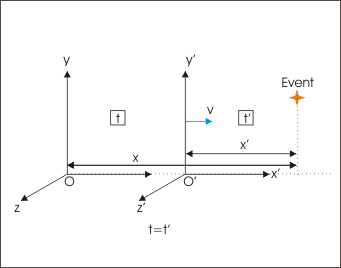Galilean invariance or Galilean relativity states that the laws of motion are the same in all inertial (or non-accelerating) frames. Galileo Galilei first described this principle in 1632 using the example of a ship travelling at constant velocity, without rocking, on a smooth sea; any observer doing experiments below the deck would not be able to tell whether the ship was moving or stationary. The fact that the Earth orbits around the sun at approximately 30 km/s offers a somewhat more dramatic example, though it is technically not an inertial reference frame.
Specifically, the term Galilean invariance today usually refers to this principle as applied to Newtonian mechanics—that is, Newton's laws hold in all inertial frames. In this context it is sometimes called Newtonian relativity. Among the axioms from Newton's theory are:
- There exists an absolute space in which Newton's laws are true. An inertial frame is a reference frame in relative uniform motion to absolute space.
- All inertial frames share a universal (or absolute) time.
Derivation
Galilean relativity can be shown as follows. Consider two inertial frames S and S'. A physical event in S will have position coordinates r = (x, y, z) and time t; similarly for S'. By the second axiom above, one can synchronize the clock in the two frames and assume t = t'. Suppose S' is in relative uniform motion to S with velocity v. Consider a point object whose position is given by r = r(t) in S. We see that
This transformation of variables between two inertial frames is called Galilean transformation . Now, the velocity of the particle is given by the time derivative of the position:

Galilean Invariance
Newtonian mechanics is invariant under a Galilean transformation between observation frames (shown). This is called Galilean invariance.
Another differentiation gives the acceleration in the two frames:
It is this simple but crucial result that implies Galilean relativity. Assuming that mass is invariant in all inertial frames, the above equation shows that Newton's laws of mechanics, if valid in one frame, must hold for all frames. But it is assumed to hold in absolute space, therefore Galilean relativity holds.
Issues
Both Newtonian mechanics and the Maxwell's equations were well established by the end of the 19th century. The puzzle lied in the fact that the Galilean invariance didn't work in Maxwell's equations. That is, unlike Newtonian mechanics, Maxwell's equations are not invariant under a Galilean transformation. Albert Einstein's central insight in formulating special relativity was that, for full consistency with electromagnetism, mechanics must also be revised, such that Lorentz invariance (introduced later) replaces Galilean invariance. At the low relative velocities characteristic of everyday life, Lorentz invariance and Galilean invariance are nearly the same, but for relative velocities close to that of light they are very different.